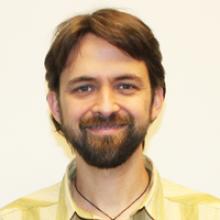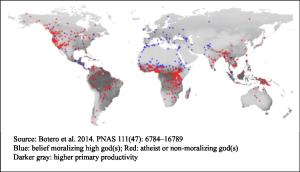What factors shape the religious beliefs of different groups of people? A team of international researchers – which included CSU Professor Michael Gavin- recently set out to answer that question.
The team created a comprehensive model that analyzes the d egree to which historical, cultural, social, political, and environmental factors influence religious beliefs – specifically a group’s inclination to believe in a moralizing god or gods. The model is able to predict with more than 90 percent accuracy whether or not different societies adhere to a religion with moralizing gods.
egree to which historical, cultural, social, political, and environmental factors influence religious beliefs – specifically a group’s inclination to believe in a moralizing god or gods. The model is able to predict with more than 90 percent accuracy whether or not different societies adhere to a religion with moralizing gods.
The results were detailed recently in a paper entitled “Ecology of Religious Beliefs” published in the Proceedings of the National Academy of Science and have garnered headlines around the world.
Gavin, a professor in the Department of Human Dimensions of Natural Resources in the Warner College of Natural Resources, answered questions about the significance of the study and his role in it.
Why is the model significant? Why is it attracting attention?
I think the attention comes from the topic. We tend to all have fairly strong opinions about religion and many other cultural traits. Every one of us lives with these aspects of culture every day, and our opinions on these topics shape our lives in fundamental ways. So we all have some interest in understanding religious beliefs.
Then, when you start to look at the global patterns, the trends are striking. Our interest in this project really took off when we saw the map. If you map the societies that believe in moralizing high gods, which we defined as “supernatural beings believed to have created or govern all reality, intervene in human affairs, and enforce or support human morality”, some clear patterns emerge.
So, we began with a fairly simple question: what factors contribute to this geographic pattern in religious beliefs? But the list of possible factors is long: history, politics, social factors, the influence of neighboring societies, the environment, etc.
I think the unique contribution we made here was to take an interdisciplinary approach. We were able to use data gathered in many different fields and then apply methods developed in biogeography and evolutionary biology to analyze the data.
It’s really the first time anyone has applied those techniques to this kind of question. The title is definitely catchy and a lot of people are interested in how climate and ecology affect our beliefs, lives and culture. But what we find is that belief in moralizing high gods seems to be shaped not just by cultural transmission or by some simple ecological factors, but rather by a complex mixture of social, cultural and environmental influences.
Were there any unusual findings?
For our team, the biggest surprise was likely the map. The geographic patterns were amazing. You can see a line where the forests of Central Africa shift into the Sahara and religious beliefs change. This surprise sparked our interest in the study, and then we found that, yes, environmental harshness does have an influence, and so do several other social, cultural and historical influences.
How do you think this model will be used in the future?
I imagine the paper will be of interest to those studying religious beliefs and diversity in cultural traits in general. But more than anything the paper provides a methodological blueprint.
If we combine data and theory from different fields like anthropology, linguistics, history, archaeology, and religious studies with new analytical methods originally designed to study the distribution and evolution of other species we can begin to ask all sorts of big questions about human diversity.
For me this is an exciting time, because the meeting of different fields allows us to explore some fascinating questions about human diversity and history.
What was your role in the project?
This project involved bringing together experts from several different fields. I’ve directed two different working groups funded through the National Evolutionary Synthesis Center that have brought together diverse sets of scholars to look at both language diversity and cultural change.
This project grew out of those meetings, as experts in different disciplines began to talk about what is possible when theory, data and methods from different fields come together.
Will you continue working on this project in the future?
Our larger international research group, that includes the authors on this paper, is working on a whole series of projects that use the methods from this study and other techniques developed in evolutionary biology to try to understand cultural diversity.
Human cultural diversity is truly incredible. Humans collectively speak nearly 7000 languages, practice many different religions, and differ in so many other cultural traits. Understanding what factors shape this diversity is a huge challenge, and we think these new methods provide an exciting tool to help unravel some of these mysteries.